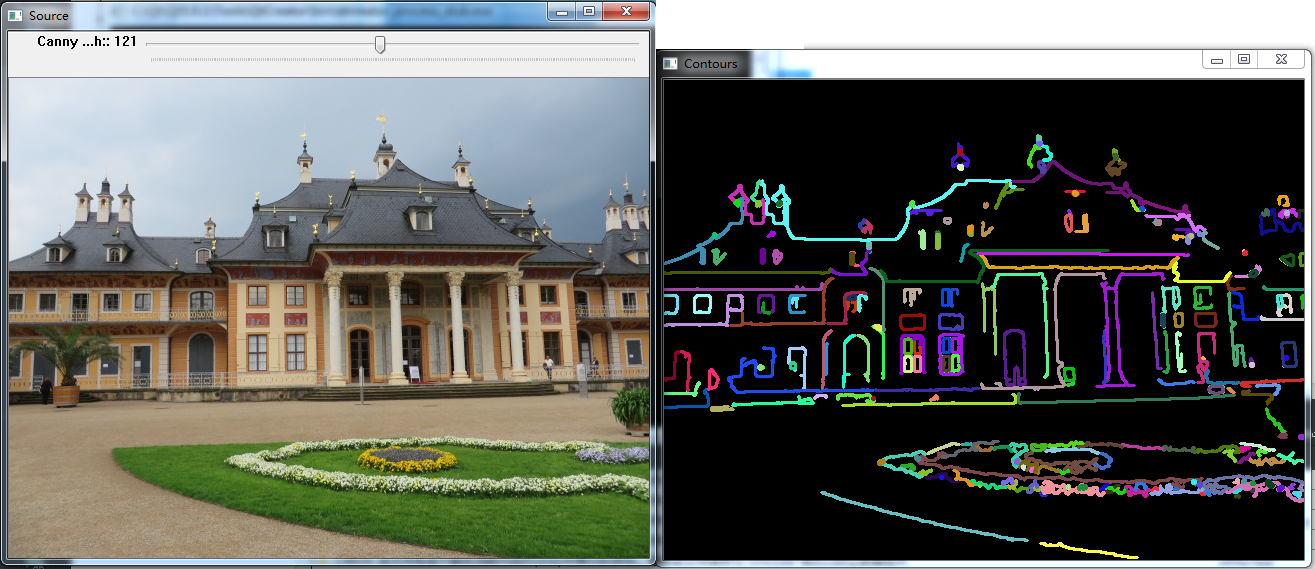1 基于阈值
灰度阈值法,是最简单、速度最快的图像分割方法,广泛用于实时图像处理领域 ,尤其是嵌入式系统中
设输入图像 ,输出图像 ,则阈值化公式为
通俗说,就是遍历图像中的像素,当像素值 时,标记 为物体像素,否则为背景像素
当各物体不接触,且在图像中 物体和背景的灰度值差别比较明显 时,阈值法是非常合适的分割方法

1.1 固定阈值
固定阈值化函数为 threshold(),如下:
1 2 3 4 5 6 7 | double threshold ( InputArray src, // 输入图像 (单通道,8位或32位浮点型) OutputArray dst, // 输出图像 (大小和类型,同输入) double thresh, // 阈值 double maxval, // 最大灰度值(使用 THRESH_BINARY 和 THRESH_BINARY_INV类型时) int type // 阈值化类型(THRESH_BINARY, THRESH_BINARY_INV; THRESH_TRUNC; THRESH_TOZERO, THRESH_TOZERO_INV) ) |
不同的阈值化类型对应的公式,如下:
1) THRESH_BINARY
2) THRESH_TRUNC
3) THRESH_TOZERO
1.2 自适应阈值
整幅图像使用同一个阈值做二值化,对于一些情况并不适用,尤其是当图像中的不同区域,照明条件各不相同时。此时,需要自适应阈值算法
该算法可根据像素所在的区域,确定一个适合的阈值,对于一幅图中光照不同的区域,可取各自不同的阈值做二值化
目前有 MEAN_C 和 GAUSSIAN_C 两种算法,OpenCV 中的自适应阈值化函数为 adaptiveThreshold(),如下:
1 2 3 4 5 6 7 8 9 | void adaptiveThreshold ( InputArray src, // OutputArray dst, // double maxValue, // int adaptiveMethod, // 自适应阈值算法 int thresholdType, // 阈值化类型,同 threshold() 中的 type int blockSize, // 邻域大小 double C //) |
1.3 示例
全局阈值和自适应阈值的比较,代码如下:
1 2 3 4 5 6 7 8 9 10 11 12 13 14 15 16 17 18 19 | #include "opencv2/imgproc.hpp"#include "opencv2/highgui.hpp"using namespace cv;int main(){ // read an image Mat img = imread("sudoku.png", IMREAD_GRAYSCALE); // adaptive Mat dst1, dst2, dst3; threshold(img, dst1, 100, 255, THRESH_BINARY); adaptiveThreshold(img, dst2, 255, ADAPTIVE_THRESH_MEAN_C, THRESH_BINARY, 11, 2); adaptiveThreshold(img, dst3, 255, ADAPTIVE_THRESH_GAUSSIAN_C, THRESH_BINARY, 11, 2); // ... ... waitKey();} |
对比结果如下:

2 基于边缘
OpenCV 之 边缘检测 中,介绍了三种边缘检测算子: Sobel,Laplace 和 Canny 算子
但边缘检测的结果是离散的点,不能作为图像分割的结果,必须将边缘点沿着图像的边界连接起来,形成边缘链
2.1 轮廓函数
OpenCV 中,可在图像的边缘检测之后,使用 findContours() 寻找到轮廓,该函数参数如下:
image 一般为二值化图像,可由 compare, inRange, threshold , adaptiveThreshold, Canny 等函数获得
1 2 3 4 5 6 7 8 | void findContours ( InputOutputArray image, // 输入图像 OutputArrayOfArrays contours, // 检测到的轮廓 OutputArray hierarchy, // 可选的输出向量 int mode, // 轮廓获取模式 (RETR_EXTERNAL, RETR_LIST, RETR_CCOMP,RETR_TREE, RETR_FLOODFILL) int method, // 轮廓近似算法 (CHAIN_APPROX_NONE, CHAIN_APPROX_SIMPLE, CHAIN_APPROX_TC89_L1, CHAIN_APPROX_TC89_KCOS) Point offset = Point() // 轮廓偏移量) |
hierarchy 为可选的参数,如果不选择该参数,则可得到 findContours 函数的第二种形式
1 2 3 4 5 6 7 | void findContours ( InputOutputArray image, OutputArrayOfArrays contours, int mode, int method, Point offset = Point()) |
drawContours() 函数如下:
1 2 3 4 5 6 7 8 9 10 11 | void drawContours ( InputOutputArray image, // 目标图像 InputArrayOfArrays contours, // 所有的输入轮廓 int contourIdx, // const Scalar & color, // 轮廓颜色 int thickness = 1, // 轮廓线厚度 int lineType = LINE_8, // InputArray hierarchy = noArray(), // int maxLevel = INT_MAX, // Point offset = Point() // ) |
2.2 例程
代码摘自 OpenCV 例程,略有修改
1 2 3 4 5 6 7 8 9 10 11 12 13 14 15 16 17 18 19 20 21 22 23 24 25 26 27 28 29 30 31 32 33 34 35 36 37 38 39 40 41 42 43 44 45 46 47 48 49 50 51 52 53 54 55 56 57 | #include "opencv2/imgcodecs.hpp"#include "opencv2/highgui.hpp"#include "opencv2/imgproc.hpp"using namespace cv;using namespace std;Mat src,src_gray;int thresh = 100;int max_thresh = 255;RNG rng(12345);void thresh_callback(int, void* );int main( int, char** argv ){ // 读图 src = imread("Pillnitz.jpg", IMREAD_COLOR); if (src.empty()) return -1; // 转化为灰度图 cvtColor(src, src_gray, COLOR_BGR2GRAY ); blur(src_gray, src_gray, Size(3,3) ); // 显示 namedWindow("Source", WINDOW_AUTOSIZE ); imshow( "Source", src ); // 滑动条 createTrackbar("Canny thresh:", "Source", &thresh, max_thresh, thresh_callback ); // 回调函数 thresh_callback( 0, 0 ); waitKey();}// 回调函数void thresh_callback(int, void* ){ Mat canny_output; vector<vector<Point> > contours; vector<Vec4i> hierarchy; // 边缘检测 + 轮廓 Canny(src_gray, canny_output, thresh, thresh*2, 3); findContours( canny_output, contours, hierarchy, RETR_TREE, CHAIN_APPROX_SIMPLE, Point(0, 0) );<br> // 画轮廓 Mat drawing = Mat::zeros( canny_output.size(), CV_8UC3); for( size_t i = 0; i< contours.size(); i++ ) { Scalar color = Scalar( rng.uniform(0, 255), rng.uniform(0,255), rng.uniform(0,255) ); drawContours( drawing, contours, (int)i, color, 2, 8, hierarchy, 0, Point() ); } namedWindow( "Contours", WINDOW_AUTOSIZE ); imshow( "Contours", drawing );} |
以 Dresden 的 Schloss Pillnitz 为源图,输出如下:

参考资料
OpenCV Tutorials / imgproc module / Basic Thresholding Operations
OpenCV Tutorials / imgproc module / Finding contours in your image
OpenCV-Python Tutorials / Image Processing in OpenCV / Image Thresholding
《Image Processing, Analysis, and Machine Vision》4th,ch6
Topological structural analysis of digitized binary images by border following [J], Satoshi Suzuki, 1985
更新记录
2020年4月26日,增加 “1.3 自适应阈值化” 和 “1.4 示例 - 自适应阈值代码”
原文链接: http://www.cnblogs.com/xinxue/
专注于机器视觉、OpenCV、C++ 编程




【推荐】国内首个AI IDE,深度理解中文开发场景,立即下载体验Trae
【推荐】编程新体验,更懂你的AI,立即体验豆包MarsCode编程助手
【推荐】抖音旗下AI助手豆包,你的智能百科全书,全免费不限次数
【推荐】轻量又高性能的 SSH 工具 IShell:AI 加持,快人一步
· AI与.NET技术实操系列:向量存储与相似性搜索在 .NET 中的实现
· 基于Microsoft.Extensions.AI核心库实现RAG应用
· Linux系列:如何用heaptrack跟踪.NET程序的非托管内存泄露
· 开发者必知的日志记录最佳实践
· SQL Server 2025 AI相关能力初探
· winform 绘制太阳,地球,月球 运作规律
· 震惊!C++程序真的从main开始吗?99%的程序员都答错了
· AI与.NET技术实操系列(五):向量存储与相似性搜索在 .NET 中的实现
· 【硬核科普】Trae如何「偷看」你的代码?零基础破解AI编程运行原理
· 超详细:普通电脑也行Windows部署deepseek R1训练数据并当服务器共享给他人